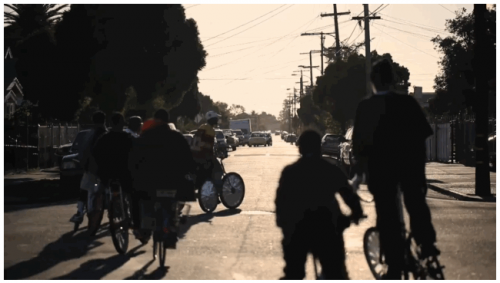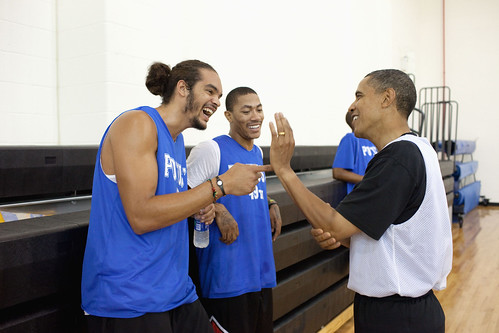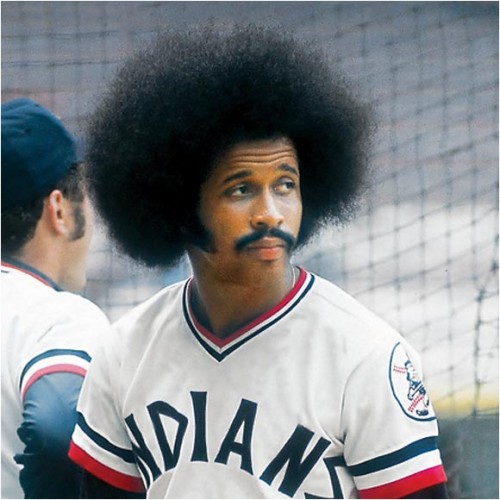Yesterday afternoon I watched Roy Halladay's no-no on the Hot Corner, which is Major League Baseball's concession to the Internet. The Hot Corner allows you to choose a single camera angle from which to watch the game, which has the advantage of showing you stuff you might not see in the multi-camera, frequent-cut-away televised experience. The downside is that you miss everything that happens outside of that single camera frame, which, as it turns out, is a lot. When Halladay was pitching, I chose the angle that kept the camera on his face the entire time, and this time I didn't miss much because every single important moment happened right there. You could sense (not "see" exactly) the flow that Halladay was in; the announcers kept remarking on how "calm" he looked, but it wasn't calmness as much as it was quiet, focused intensity.
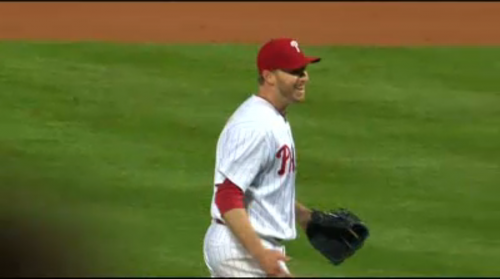 The final out.
The final out.
The New Yorker's Roger Angell even mentions the flow in a blog entry about the game:
Pitching his no-hit, 4–0 masterpiece against the Cincinnati Reds last night, the Phillies’ ace Roy Halladay restored the smoothing, almost symphonic sense of pleasure that lies within the spare numbers and waiting possibilities of every ballgame. Even from a distance, at home again in your squalid living-room loge, you felt something special this time about the flow of pitches, balls and (mostly) strikes, the inexorably approaching twenty-seventh man retired …
And of course the Philly fans were deeply engaged throughout the game. In the later innings, each strike was cheered, and Reds batters received hearty, cascading boos each time they asked for time to try to disrupt Halladay's rhythm.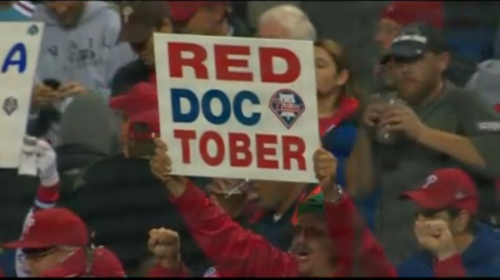 This guy brought the right sign to the game.
This guy brought the right sign to the game.
The remainder of the post-season will have to be pretty remarkable to out-shine this unique achievement. (And I personally hope that the Giants are up for it).
 Shinya Kimura is a custom motorcycle builder, and the subject of a beautiful short profile on YouTube.
Shinya Kimura is a custom motorcycle builder, and the subject of a beautiful short profile on YouTube.
Only worn when mobbin'
So I was catching up with the haps in my new city today on Berkeleyside, and I noticed a reference to yet another cool thing that originated in Oakland. No, it's not turf dancing, or whistle tips, or ghost riding, or even hyphy. It's scraperbikes, old beaters totally tricked out with colorful, cheap, homespun decorations. Not only are they cool-looking, the scraper crew wrote some by-laws to keep it all legit:
In order to become a member of the Original Scraper Bike Team, you must: Be a resident of Oakland, CA. Be at least 7y/o or older. Retain A 3.0 Grade Point Average (GPA), Create your own Scraper Bike…(It Has To Be Amazing, Or Else You Can't Ride.) A single-file line when riding. After 10 rides The Scraper Bike King and his Captains will decide if your bike is up to standards and if you can follow simple guidelines. After your evaluation we will consider you a member and honor you with an Original Scraper Bike Team Shirt. Only worn when Mobbin'.
The above quote, and the still are from a beautiful short movie called Scrapertown by Zackary Canepari & Drea Cooper, which you should definitely watch for the sheer awesome camerawork alone. They have a series of lovely videos about California called California is a place, also worth checking out.
Cycling seems more dangerous, more hassle-filled, and generally more aggro than when I moved here. Why? Maybe it's me. I moved to Berkeley recently, and I'm pretty close to having a lawn that I can tell kids to get off of. Maybe it's that the city has changed a lot. There are more cyclists, more people in general (60,000!) and more density, especially downtown. On the other hand, there are more bike lanes and signage, and there's more bike awareness among the pedestrian and motorist populations. You'd think that more cyclists + more cycling awareness + more cycling accommodation would have resulted in some kind of net improvement, but it hasn't. Pedestrians seem more antagonistic to bikes; motorists of all types are much more antagonistic; and some of my fellow cyclists seem to be the most antagonistic of all. Why?Felix Salmon has written a really interesting, and widely quoted, "unified theory" of cycling that touches on what I think is the heart of it all: That most cyclists think they're pedestrians, when we're actually more like motorists.
Bikes can and should behave much more like cars than pedestrians. They should ride on the road, not the sidewalk. They should stop at lights, and pedestrians should be able to trust them to do so. They should use lights at night. And — of course, duh — they should ride in the right direction on one-way streets. None of this is a question of being polite; it's the law. But in stark contrast to motorists, nearly all of whom follow nearly all the rules, most cyclists seem to treat the rules of the road as strictly optional. They're still in the human-powered mindset of pedestrians, who feel pretty much completely unconstrained by rules.
I really agree with this. I don't know how to make it so, and I'm really not a law-and-order type. But I think that agreeing to follow the rules of the road would do a lot to make us all more predictable. Also, I'd like to add: Pass on the freakin left.
Aw, man. It just got a little dusty in my office at Cooper. Seeing my old childhood home in Leawood, Kansas will do that, especially when the Arcade Fire provides the soundtrack and when Google engineers work with a music video director to create the experience.
The photo above is from an "interactive video" called "The Wilderness Downtown," and it's actually as technologically interesting as it is emotionally-provocative. (It's especially emo if the Google Maps satellite imagery from your home looks appropriately old and nostalgic; see image above). Anyway, it's referred to as an "experiment" with Google's Chrome browser, which is probably why, at times, it started to feel like a showcase of whizzy HTML5 elements — windows get launched and shuffled around; you're asked to scribble on the screen; graphics are animated and layered. I don't know, maybe I'm just the right mix of cheeseball and geek, but it kind of worked for me.
Something which can last
There's a great three-minute account of a meeting with Borges. About the life of an artist, he says:
The task of art is to transform what is continuously happening to us, to transform all these things into symbols, into music, into something which can last in man's memory … as the years go by, if the stars are on your side, you may discover that you are at the center of a vast circle of invisible friends whom you will never get to know but who love you. And that is an immense reward.
Via The Times:
Kirk Douglas had a son, the little-remembered Eric Douglas, who was an actor and stand-up comedian. He once came over to the UK to do some gigs and inadvertently created one of British comedy's finest legends. Eric wasn't having a great gig at a London club; he was going down the pan. His opening line, I seem to remember, focused on the fact that he lacked the cleft in his chin possessed by both his father and brother. The audience was not in the least interested. Their indifference eventually overwhelmed him and he finally shouted: "Do you know who I am? I'm Kirk Douglas's son!" The room looked on in silence, then someone in the audience stood up and said: "No, I'm Kirk Douglas's son." He was swiftly followed by several more. Within seconds, the entire audience was on their feet, all claiming to be Kirk Douglas's son, in a pitch-perfect parody of the scene in Spartacus. That, by anyone's standards, is a tough gig.
Read on: A nice discussion of the dark side of heckling going on at The Guardian.
Presidential
There's an intimacy in this that so resonates with me. I mean, it's impossible to imagine that I wouldn't be charmed by the subject matter alone — a President I greatly admire, plus two NBA players. But this moment is especially great, because I love Derrick Rose's game and I will always appreciate that he OD'd on candy before the 2008 NCAA Final with Kansas. And I admire Joakim Noah's gritty post play and his serious media game. And I love that there's genuine emotion in this shot. It has got a little bit of stagey-ness, but it also feels, like I said, intimate, like the photographer took this photo and emailed it to me, and said: "You'd appreciate this."
All this time, I thought the best thing about Oscar Gamble was his epic afro. But now I've learned that the title of this post is said to have originated from Gamble during a discussion of the 1975 Yankees; those were the early days of George Steinbrenner's tenure, and the first of Billy Martin's five managerial stints. And yeah, Gamble's assessment sounds about right to me. (I first saw it in the comments section of an excellent post by Joe Posnanski, which is worth reading for the wealth of sports quotes).

